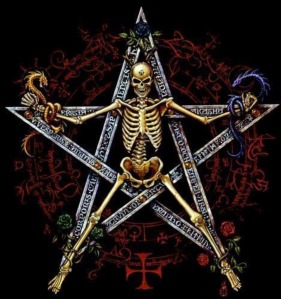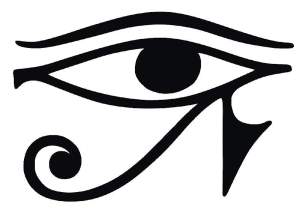Notes on the role of the historical Egregore in modern Magic
by Fra.: U.D.
It is quite easy to poke fun at the historical claims of most magical and mystical orders, especially when they purport to have derived from “very ancient”, possible even “Atlantean” or, to top it all, “pre-Atlantean” brotherhoods for whose existence even the most sypathetic historical scholar worth his name would be very hard pressed to find any significant proof. Actually, it is rather a cheap joke to cite, for example, AMORC`s claims that even good old Socrates or Ramses II (of all people!) were “Rosicrucians”. However, the trouble only starts when adepts mistake these contentions for literal truths. “Literal”, of course, derives from literacy and the letters of the alphabet. And, as Marshall MacLuhan has justly in his “Understanding Media” and perhaps even more so in “The Gutenberg Galaxy”, western civilisation has a very strong tendency towards linear thinking, very probably due to – at least in part – the linear or non-pictographic nature of our alphabet. The very structure of this alphabet informs us at quite a tender age to think in terms of linear logics such as cause and effect, or, more intersetingly in our context, PAST-PRESENT-FUTURE. This is not at all a “natural necessity” as most people are wont to think, for the ideographic or pictographic “alphabets” as used for example in ancient Egypt or even modern China and Japan tend to bias the correspondingly acculturalised mind towards what MacLuhan terms “iconic thinking” – a perception of holistic factors rather than the systematisation into seperate (preferably indivisible) single units. Western thought has formulated this problem as the dichtonomy of the analytic and the synthetic approach. But it is perhaps no coincidence that our contemporary culture tends to associate “synthetic” with “artificial” , vide modern chemistry.
Now magical and mystical thinking is quite different; in fact it is not half as interested in causality as is linear thought. Rather, it strives to give us an overalll, holistic view of processes within our perceived space-time continuum; an overall view which includes the psychology of the observer to a far stronger degree than even modern physics seems to have achieved in spite of Heisenberg’s uncertainity principle and Einstein’s earlier theory of relativity. In other words, mythological thinking is not so much about literal (“alphabetic”?) truth but rather about the “feel” of things. For example, a shaman may claim that the current rain is due to the rain goddess weeping because of some sad event. He might predict that her phase of mourning will be over in two days’ time and that the deluge will then end. A Western meteorologist might possibly come to similar prognoses, but he will of course indignantly deny using any of “this mystic stuff” in the process. His rain godess takes the form of barometric pressure, wind velocity and direction, air humidity and the like – but who is to say which view is the “truer” one, as long as abstract and mystic predictions prove to be accurate? From an unbiased standpoint, the modern demons “barometric pressure”, “wind velocity” and factors of a similar like are just as abstract and mythic as the shaman’s hypothetical rain goddess – especially so for us laymen who religiously follow the daily indoctrination via the TV weather forecasts and satellite photograph divination: all we can do is believe in what the expert tells us is the truth. The non-shaman in a shamanic society shares a very similar fate when he has to believe simply that the rain goddess wants to be comforted say, by a substantial donation of meat or tobacco in the course of a fully fledged tribal ritual.
There is an important difference however. If we accept the model (strongly propagated by A.O. Spare, who was, of course, in his very special manner, quite an orthodox Freudian) of magic primarily taking place within the subconscious (Freud) or, less ambiguous, the unconscious (Jung); and if we furthermore agree that said unconscious is not only the source of personal magical energy (mana, or, as I prefer to term it, magis) but tends to think and act in symbols and images, we might come to the conclusion that our shaman`s explanation may perhaps not be scientifical more satisfying in Western terms, but it is surely more in accord with the way our unconscious tends to perceive reality. In that sense it is not only more “natural” but, one suspects, even downright healthier for psychic hygiene. It is, so to speak, more “ecological and holistic” in terms of psychic structure.
As an aside I might mention that it is the better explanation for practical magical reasons as well. For at least rain goddesses can be cajoled into happiness by magical technique, ritual trance and the like until they stop weeping, a task a meteorologist will hardly be able to imitate. (Actually I have preferred the magic of rain prevention to the more classical example of rain making because it is far more relevant to our own geography and experience).
In recent years Rupert Sheldrake`s theory of morphogentic fields has raised quite a hue and cry, not only within the confines of the scientific community but strangely enough among occultists too. I find this latter reaction quite astonishing, because a lot of what Mr. Sheldrake basically claims is nothing more than the old, not to say ancient, tenet of philosophical idealism: namely that there is what in both German and English is called “Zeitgeist”, a form of unique time-cum-thought quality, leading to surprisingly similar albeit completely independent models of thought, technical inventions, political truths and so on. One would rather expect the people to be profoundly intrigued to be among materialist/positivist biologists or physicist rather that occultists who have traded in the Zeitgeist principle ever since occult thought proper as we understand it arose in the Renaissance.
From a pragmatic point of view Mr. Sheldrake is behaving very much like our meteorologist, replacing mythic explanations with crypto-mythic “scientific” factors. Unfortunately, most scientific scholars tend to fear a devaluation of scientific termini tecnici; once they are mentioned in the wrong “context” (almost invariably meaning: by “wrong” people) they are readily labelled as “non-” or “pseudo-” scientific – which is, after all, precisely what happened to poor Mr. Sheldrake amongst his peers in spite of all his academic qualifications. This example goes to show how very much estranged occultists can be from their own sources even when working with them daily.
Reality too is always the reality of its description: we are marking our pasts, presents and futures as we go along – and we are doing it all the time, whether we are conscious of the fact or not, whether we like it or not, we are constantly reinventing our personal and collective space-time continuum.
Space seems rather solid and unbudging; even magic can do very little it seems to overcome its buttresses of solidity and apparent inertia, occasional exceptions included. (May it be noted that I include matter in this space paradigm, because solid matter is usually defined by the very same factors as is space – namely width, length and height.) Time, on the other hand, is much more volatile and abstract, so much so in fact that it is widely considered to be basically an illusion, even among non-occultist laymen. And indeed in his famous novel “1984” George Orwell has beautifully, albeit perhaps unwillingly, illustrated that history is very little more than purely the description of history. (Which is why it has to be rewritten so often. It seems that mankind is not very happy with an “objective past” and prefers to dabble in “correcting” it over and again. This is quite an important point I shall refer to again later on.) History is, after all, the defining of our past own roots and our present position within our linear space-time continuum in relation to past and future. Very often, unfortunately, the description and interpretation of history seem little more pathetic endeavour to obtain at least a minimum of objectivity in a basically chaotic universe. The expression “ordo ab chao” is more or less a summary of Western thought and Weltanschauung, of the issues straining and stressing the Western mind since ancient Greece. Chaos is considered “evil”, order on the other hand is “good” – then the political philosophy, if you care to dignify it by this terms, of “law and order”, appeals to people`s deeply rooted fears of loss of stability and calculability. (“Anarchy” is another widely misunderstood case in point.) The ontological fact that everything is transitory has never been particular well-received in Western philosophy and theology.
Now before you get the impression that I am only trying to impose a typical exercise in heavyhanded Teutonic style philosophical rambling upon your overbusy reading mind, let me hasten to point out that if past, present and future are, at least in principle, totally subjective, we as magicians are locally perfectly free to do what we like with them. For the magician is a) the supreme creator of his own universe and b) the master of Illusion (ref. the Tarot card “The Magician/Juggler”). This freedom of historical choice, however, is seldom realised let alone actively applied by the average magician. Maybe one of the reasons for this has to do with the somewhat pathetic fact that most of us tend to live our lives in a more or less manner, being mild eccentrics at best, distinctly avoiding becoming too much over the top. There are a number of possible explanations for this, ranging from “every magician is just another guy/gal like me” to “prevention of insanity”. As we deal all the time with insanity – i.e. extremely unorthodox states of consciousness by bourgeois standarts, we magicians prefer some stability in our everyday lives and makeups, but this is not really our topic.
Rather than delve into social normality of the average magician I should like to investigate the many bogus claims to antiquity as put forward by a multiple of magical and mystical orders from this point of view. Such orders range from Freemasonry, Rosicrucianism and Theosophy to such venerable institutions as the O.T.O., the Golden Dawn and many others. Their historical claims are usually quite stereotyped: the spectrum covered includes Atlantis, Lemuria, Mu, Solomon, Moses, Dr. Faustus, St. Germain, the Gnostics, the Knight Templar,the Cathars, the Illuminati, the Holy Grail myth, prehistoric witchcraft, matriarchy, shamanism etc.
Now it is quite common for shamans, to cite one example, to claim that in the good old days (usually, of course, dating back to a non-calibrated, non-defined time immemorial) things used to be much, much better. One of the more profane reasons for this contention may be the fact that most of these shamans have already achieved quite a venerable age in their trade; and don`t we all know the typical attitude of old crones towards modernity ? It may not sound particular spiritual or holy but maybe all we are seeing here is the primitive`s parallel to the “Now when I was in Poona with Royal Indian Army, young lad…” reported occasionally to be heard in some of today`s pubs.
But there is more to it, I think. By calling up “bogus” ancestors from Moses via Solomon to Dr. Faustus and St. Germain, the magician not only reinvents his own history, he also is summoning up the egregore of these “entities” (along with all their powers and inhibitions of course) – or, to put into Mr. Sheldrake`s terminology, their morphic fields. By violating all the painstakeing endeavours of the meticulous historian, by simply ignoring a number of tedious and possibly contradictory facts and questions (such as whether Moses and Solomon have ever really been sorcerers of some standing in their own time) the magician becomes God in the fullest sense of the expression: not only does he choose his relatives in spirit quite arbitrarily, he even claims the right to do what not even the judaeo-christian god of the old testament is ever described as doing, namely changing “objective past” at will.
This type of creative historicism appeals, so it seems, very strongly to the unconscious mind, supplying it with a great deal of ideological back-up information, thus reducing its conscious-mind-imposed limits of “objectivity” to at least some modicum of superficial probability. It is only when the occultist mixes up the different planes of reference, when he purports to speak of “objective linear truth”, instead of mythic or symbological, decidedly non-linear truth, that serious problems arise.This should be avoided at all costs in order not to strain our psychic set-up by contradictory evidence, which can easily result in an unwilled-for neutralisation of all magic powers.
But this, of course, is the same problem as with occult scientism. “Rays” are quite a convincing hypothesis to base telepathic experiments on, as long as you don`t try to overdefine said rays by epitheta such as “electromagnetic” or the like. For if you do, you become the victim of scientists`zealous inquisition boards. Or, as Oscar Wilde might have put it, it is not truth which liberates man`s mind but lying. (Which, again, is one of the reasons why Aleister Crowley entitled his magnum opus “The Book of Lies” in the first place…)
Let us then resort to _creative historicism_ whenever we find it useful. Let us not have “historical objectivity” dictated to us by the powers that be. Let us accept our fuzziness of expression which is, after all, little more than a honest acknowledgement of the fact that symbols and images are always more than just a little ambiguous, as our dreams well prove every night. As in divination, it does not pay to become overprecise in magic: the more you try to define a spell, the higher probability of failure. It is quite easy to charge a working talisman quite generally “for wealth”; it is quite another to charge it to “obtain the sum of $347.67 on March 13th at 4.06 p.m. in 93, Jermyn Street, 3rd floor” and still expect success. While the latter may strangely enough succeed occasionally, this is usually only the freak exception of the rule. However, by systematically rewriting our past in fuzzy terms, possibly eventing past lives and biographies for ourselves consciously or arbitrarily, we are fulfilling the final demand of Granddaddy Lucifer`s “non serviam”. Let nobody impose his or her time and history parameters on you!
And for practical exercise, allow your clock occasionally to be well in advance of your contemporaries`; let it sometimes lay behind for a few hours and minutes (do not just change the hour hand as this would make it easy to recalculate into demiurge`s “real” space-time continuum, making you yet again its slave!) Do this to learn about your former ill-advised humility towards the current time paradigm – and about the illusory character of time and its measurement in general. Rewrite your personal and family history daily, invent your own kin and ancestors. “Problems with Mom and Dad? Pick a new couple!” Experiment with retroactive spells, try to heal your friend`s flu before he even contracted it. But do this in a playful spirit lest your censor should whack you for your constant violations of the rules of this game by again confusing the frames of reference. Jump from one parallel universe to the next one, never permit yourself to stand still and become enmeshed by Maya`s veil (you are supposed to be the Master of illusion, remember?). And don`t panic: for nothing is true, everything is permitted.
* Origin: ChaosBox: Nothing is true -> all is allowed… (2:243/2)









